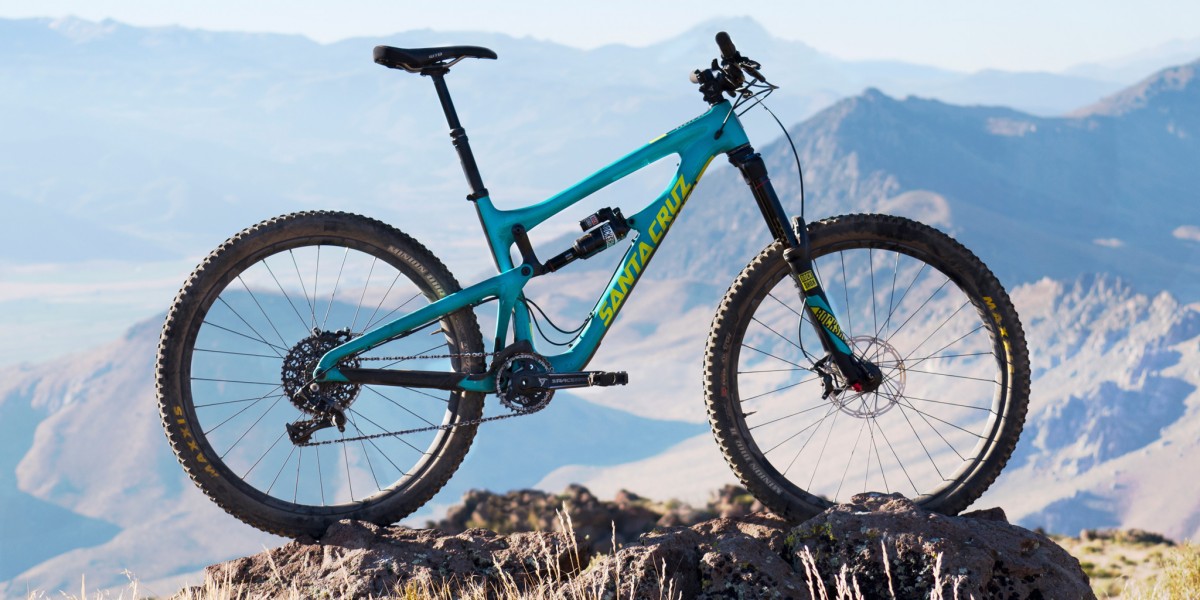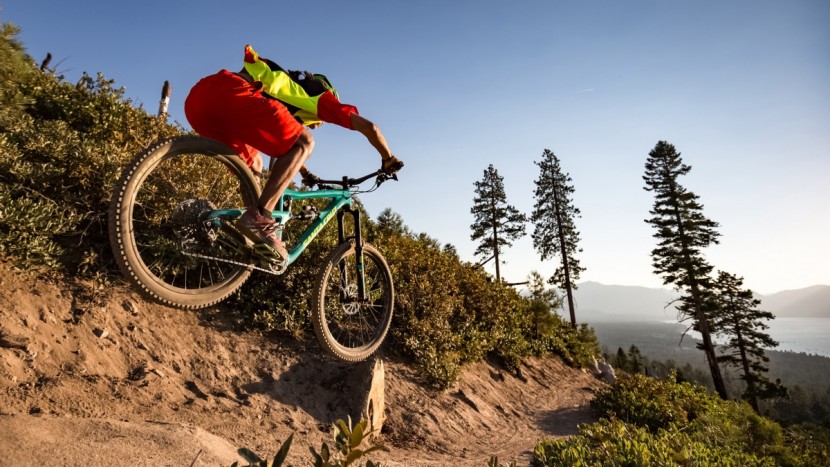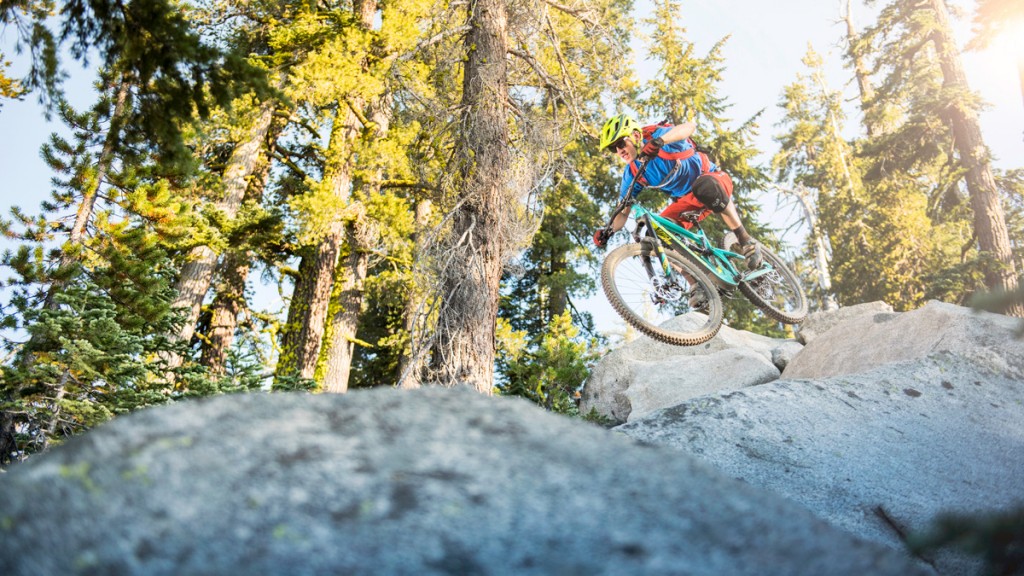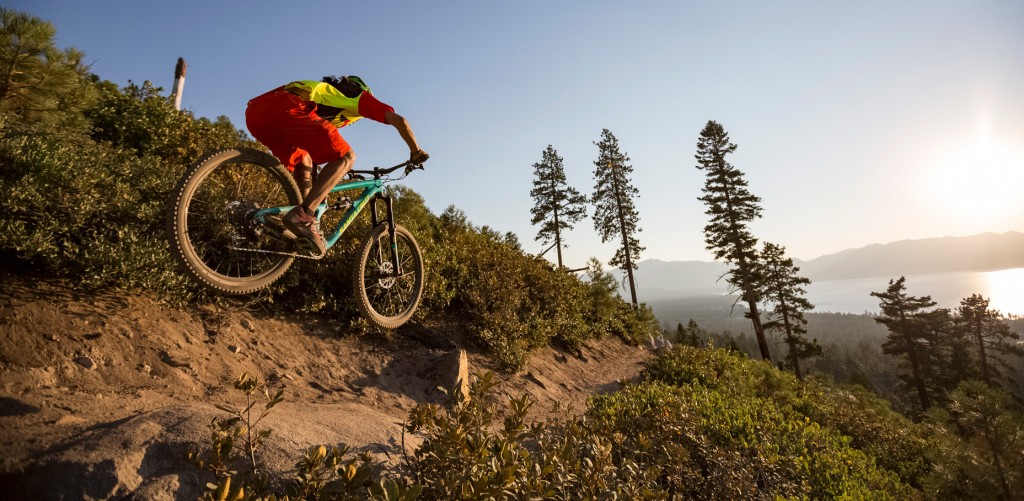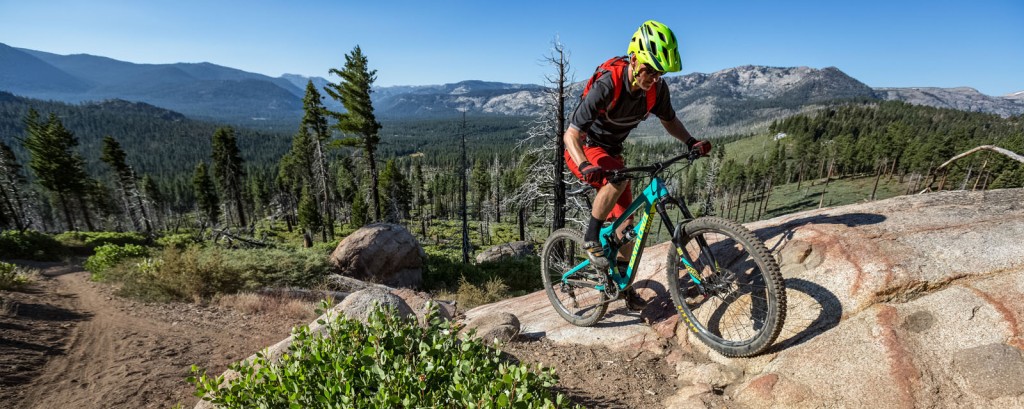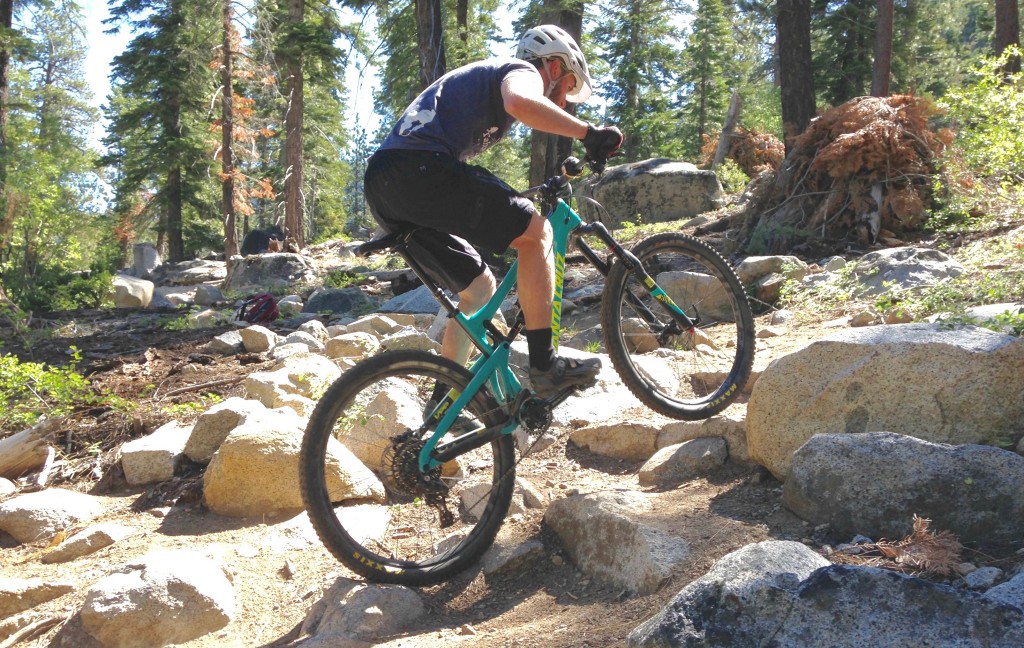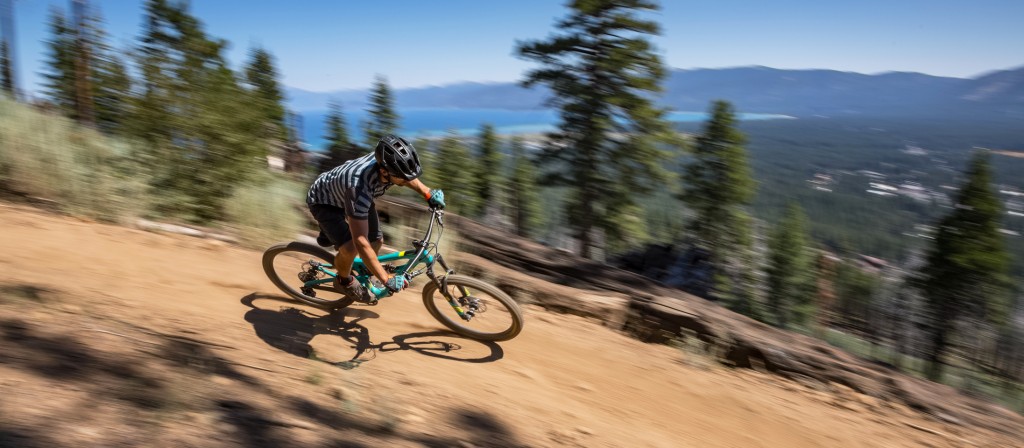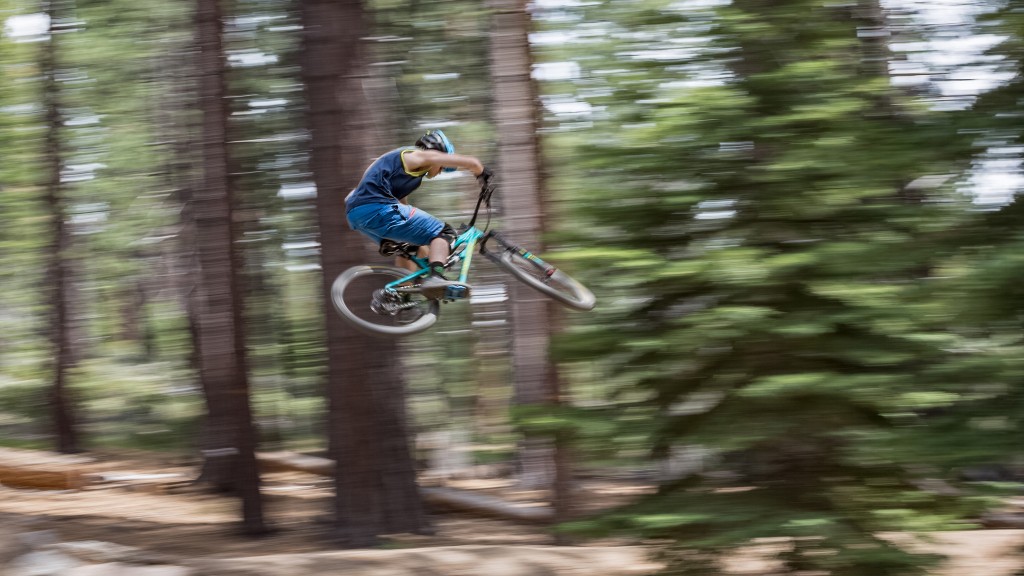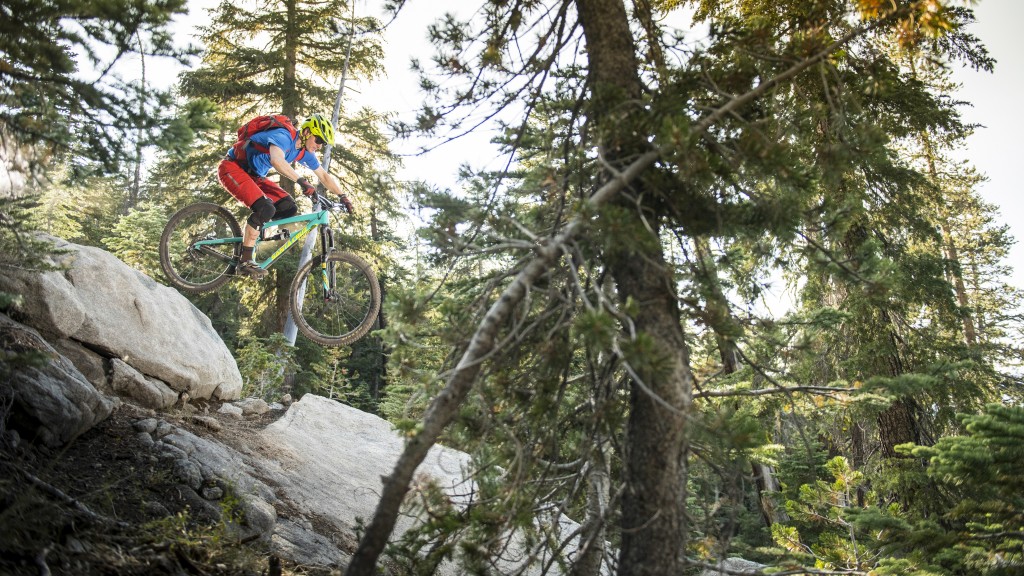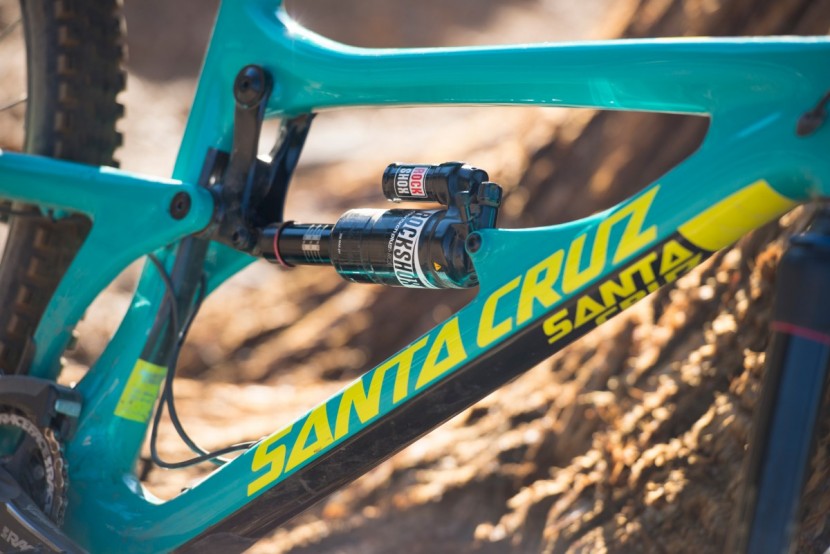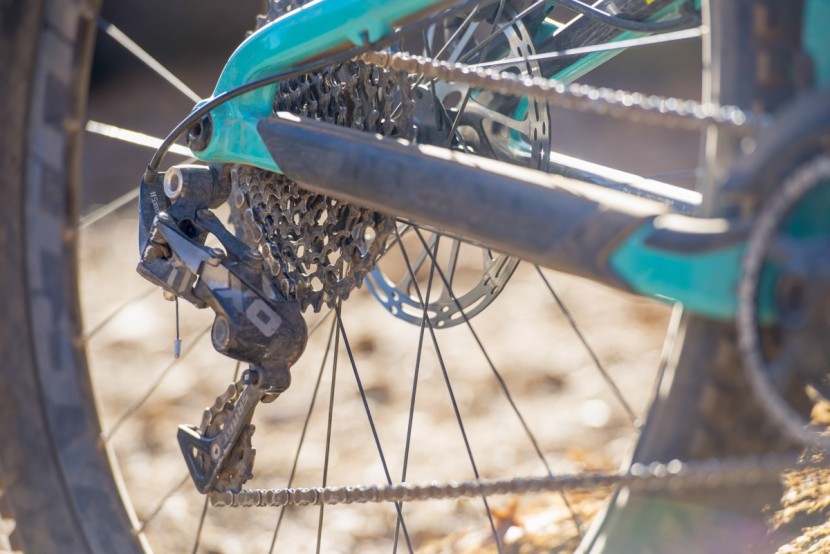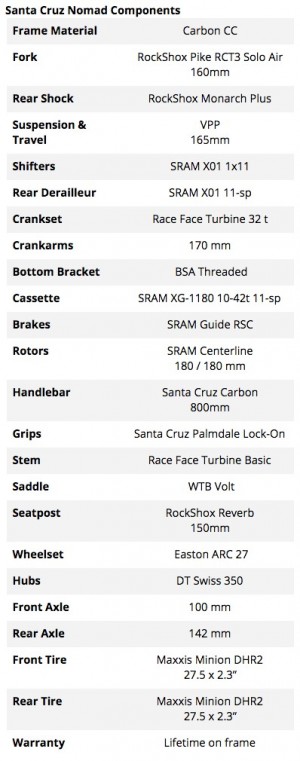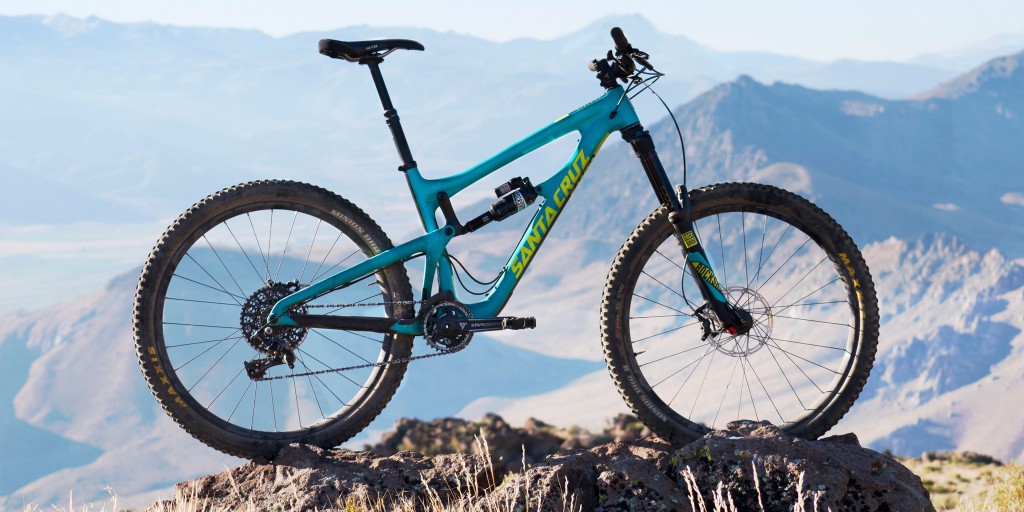Santa Cruz Nomad X01 2016 Review
Our Verdict
Our Analysis and Test Results
Our first enduro mountain bike review lasted two months and put to use a protocol that took a year to develop. We pitted the Santa Cruz Nomad against the 2016 Yeti SB5.5 2016, 2016 Ibis Mojo HD3, 2016 Pivot Mach 6, and 2016 Specialized Enduro to find out which is the best enduro mountain bike. Four pro testers pounded out hundreds of trail miles in our exhaustive testing process. In addition such extensive testing, we also did very intensive testing in the form of time trails. We methodically raced the bikes against one another on carefully developed enduro courses. See the results below.
Best Applications
At the end of our two month testing period, every one of our riders wanted a Nomad, but we also agreed that we wouldn't want it as our only ride. It's not the most versatile bike in the test. That prize goes to the Yeti SB5.5c. In the balancing act between descending prowess and climbability, the Santa Cruz skews toward gravity, maintaining the ability to get up the hill without making concessions in downhill performance. Thus, we crowned it “most enduro” in the test. “That bike was built to go downhill fast,” says one tester.
Downhill
“Straight-lining through rock gardens, that thing is insanity,” says our lead tester. The Santa Cruz Nomad smashes rocky downhill at speed better than any other bike in the test. It is the most fun and capable bike on the downhill by far. It The Nomad is so good on the descents because it was made for them. It has the second longest wheelbase (measured at 1166.8mm) in the test and the slackest head tube angle (65.2°). These design elements, combined with a low bottom bracket, create the stability we so enjoyed at high speeds. The large cockpit also biases the rider's balance to the rear, setting you up perfectly for a sled ride.
The Santa Cruz earned a high score for downhill performance due to its comfort, ability to tackle burly technical terrain and nonstop-smile factor. This ties it with the Yeti SB5.5c, which isn't nearly as plush but rolls over everything and always manages to maintain traction. Neither earned a perfect score, as the Yeti's suspension isn't super on big hits and the fork on the Santa Cruz is more adequate than amazing. We also smashed the Nomad's pedals and cranks like crazy early in the test. Both bikes rank solidly higher than the rougher rides of the Specialized Enduro Expert and Ibis Mojo HD3. These two tied for second place with a downhill rating of 6 out of 10.- -Speed--
The Santa Cruz delivered impressive speed in our downhill tests, finishing in second place overall, just behind the Yeti. While it is one of the more sluggish bikes taking off from the starting line, the Nomad makes up time through exceptional performance once up to speed. (The Yeti, which was the fastest downhill bike, was even slower to accelerate, but this is typical of a 29er). The Santa Cruz Nomad “is a diesel for sure, not a race car,” says our lead tester, a diesel that holds speed. Its inertia keeps the momentum going and the Santa Cruz is so solid in the rock gardens that we all felt confident enough to push our speeds, equalling better times.
In contrast, the Ibis Mojo HD3 and Specialized Enduro Expert can feel racier as they reach speed more quickly. But, as we learned again and again in our testing, feeling fast is not the same as actually being fast, and the Nomad left the Ibis and Specialized Enduro in the dust in our downhill races, beating them to the finish line by 2 and 2.5 seconds respectively. These two bikes are less effective on the descents as they bias their riders in a more upright position, have somewhat steeper head tube angles and less cushy suspension systems. The Nomad also beats the Pivot Mach 6 by an average of 3.3 seconds.
That translates to a 0.9 second per minute lead over the Pivot, a 0.7 second per minute gain on the Specialized, and a 0.5 second per minute gain on the Ibis. Meaning, if you ride the Santa Cruz for an hour, you'll beat the Pivot by 54 secs and the Specialized by 42 sec.
Unfortunately, the Santa Cruz doesn't only bash downhill — it also bashes cranks. Between the low, ride-stabilizing bottom bracket and the 170 mm cranks, the entire bottom half of the pedal stroke is exposed to what could be “a ride stopping smash.” We had to back off of the pedals in some circumstances to avoid strikes, slowing speeds. Not that it made a lot of difference for first place. The Yeti flew by 2.5 seconds — or 0.7 seconds per minute — ahead of the Santa Cruz, translating to a 42 sec gain on an hour-long course.
Confidence
So. Much. Confidence. It doesn't strut, but it will make you want to. Between its stable handling, excellent tracking, deluxe suspension, relaxed head tube angle and roomy cockpit, this bike has got your back. If you find yourself too far forward it'll catch you like a baseball mitt. Offline? No worries, just ride it out. As one tester puts it: “The other bikes, you ride and tell them what to do, and that bike, you're just along for the ride,” he says. “It kinda takes care of you on downhills.” And, while it may seem that a bike so biased towards high-speed handling would be better for more advanced riders, this friendly and forgiving temperament is perfect for timid descenders. The Nomad isn't too much bike for anyone interested in improving their gravity skills.
The only thing getting in your mental way will be the possibility of one of those ride ending crank strikes or 800mm wide handlebar smacks. We were smashing pedals and cranks pretty constantly early in the test before we got good at timing our pedal strokes. Our downhill benchmark time trial course, The Scorpion, has several fast sections through narrow rock keyholes. And those wide handlebars can feel like a big liability, as the chewed up grip-ends attest. In our warm-up rides, we scrubbed a lot of speed coming into those turns, but this lessened once we got into our time trials as we got better at scanning the strike zone for hazards.
Overconfidence
Sometimes the Santa Cruz was so good at holding a line that it got us into trouble. Our line-picking vigilance waned, and we just pointed it through sections we would normally be nervous about. A few times we had to slam on the brakes or course correct because we were heading waaaay offline, and off pitch. Recovery was quick, as long as it wasn't in the midst of a tight, flat corner. Turns out, even on a ride this friendly you still have to steer.
Handling
There is zero twitchiness in this bike. It's smooth and nimble through the rockiest of gardens. Just guide the handle bars and the bike takes the hit. “You don't even have to pick a line,” says one tester. “That thing's a beast.” The faster you go the more stable the bike gets, and the more playful. At slow speeds, it doesn't hop around like the Ibis Mojo HD3, but when aggressive riders hit speed, it's super lively, jumping and popping over rocks or rough sections of trail.
Rolling slow, it can feel cumbersome, and some of our more aggressive testers cite throwing it around more than other bikes in the test. While it isn't as flickable as the Ibis Mojo HD3, it works and it's still fun.
Super balanced, the Santa Cruz Nomad requires the fewest body adjustments to ride, uphill or descending, of any of our test bikes. The bike's geometry sets you up to easily shift over the back of the bike, which is where you'll want to be for the majority of the descent. On most bikes, we normally shift forward over the bars to control the steering and avoid pedal strikes in a few of our trail's flat, tight technical squeezes. But on the Santa Cruz, that shift squirrels up the steering and detracts from rear end performance. Staying back while timing the pedal strokes to avoid strikes is a quick fix.
Our lead tester hit a crank hard enough to get slammed over the front of the bike a few times. One time the wheel decided to flop sideways. He almost went down. ("Oh s!#*, I'm going down.") Watch out for that. Even when you're sent to the bars the bike just keeps trucking, giving you plenty of time to enjoy the view from the front before settling back into a more solid position.- -Suspension and Traction--
The back is definitely the better end of the bike. While the RockShox Monarch Plus in the VPP Suspension is undoubtedly the best in the test, we did find room for improvement in the 160mm RockShox Pike RCT3 fork. It gets the job done, but out of the box, it's not as plush as the same (but boosted) fork on the Ibis Mojo HD3. It is worth noting that air volume adjustments can easily fine tune the fork to the bike and the rider.
Nailed, drilled, glued, railed — that's how we describe the traction on this bike. It's never ending, only letting up when you tell it to catch some air.
Climbing
Early in the test, the Santa Cruz was assumed to be the worst climbing bike due to its geometry. It has the slackest head tube angle (measured at 65.2°), which could easily deflect the front wheel from side-to-side, and, by our measurements, the second longest wheelbase (1166.8mm), which we figured would be tricky to weave around rocks. We thought we'd have to work for it more than any other bike in the test, giving unending input. Our assumptions were doing what assumptions do. “It's not a climbing bike,” said one test rider on day one.
But once we got over our own preconceived notions, we figured out how to ride this thing up hills, up pretty technical hills. And, while the kicked back cockpit will never be the most comfortable or inspiring to climb in, this bike can get the job done. And then there's the fact that it tied for second place in the benchmark testing time trials.
“No matter how much I ride it, I don't feel like it's the best climbing bike we have. It just doesn't feel that efficient, but the times are proving otherwise,” said one tester. “It just tractor pulls over everything.” After getting over the usual clean-and-jerk method of pulling up on the bars to place the front tire over an obstacle before rolling the back wheel up behind, we figured out that it was just going to roll over anything in the way, whether we pulled up or not. We stopped wasting unnecessary energy, and time. It still feels a bit ungainly in those tight turns, but less so than the longer Yeti SB5.5c, which has a wheelbase of 1174.8mm according to our measurements. “I can't get past feeling like it's a little bit cumbersome but uhh, despite that it just, it just gets the job done really well. I don't know what else to say,” sums up one rider.
Speed
Tying for number two with the Specialized Enduro on The Soul Grinder, our uphill time trial course, the Santa Cruz Nomad gains an average of 2.6 seconds on the last place Pivot Mach 6, and trails the Speedy GonYeti by 3.8 seconds.
That translates to a 1.2 second per minute over the Pivot but puts the Santa Cruz 1.7 seconds per minute behind the Yeti. That means that over an hour long ride, your time on the Santa Cruz would be 1:12 min:sec faster than if you had grabbed the Pivot, but 1:42 min:sec slower than if you had ridden the Yeti.
Though the Santa Cruz isn't the fastest accelerator out of tight, techy turns, it holds speed in the flats and rolls over everything in its way. In contrast, the fast rolling Specialized accelerates quickly out of the corners but worked better when it was lifted, one wheel at a time over the rock steps. Evidently, these two approaches equal similar times. The Santa Cruz climbs similarly to the Yeti SB5.5c, which also magically shrinks rocks in your way and has sluggish acceleration due to those 29" wheels. But, those big wheels also get you get further towards your goal with every rotation = faster.
Pedaling
The Santa Cruz Nomad is one of the slowest accelerators in the test, on par with the 29er Yeti and vying with the Pivot Mach 6 as the most sluggish 27.5" bike. Despite that, if in the right gear, it has plenty of get up and go. Shifting our weight slightly forward on flat tracks or slightly rearward and mashing the pedals on technical sections catches us up. “You have to work harder to get this up to speed,” says our lead tester. But once you're there, it just pedals through everything.
That statement is too literal at times, due to the Santa Cruz's pedal strike problem. While this is less dangerous on the slower climbs than the furiously fast descents, it can put you into a full on stall. And then you gotta deal with that sluggish acceleration thing all over again.
The benchmark testers choose to climb the technical test track in either the fully open or the middle, trail mode, compression setting on the fork and rear shock. The pedaling efficiency felt good for both groups. We all used the firmest compression setting when climbing pavement up to ride rocky singletrack down. While not a completely firm lockout, it pedaled very well when we were in the saddle. But, as expected, when you shift to a harder gear and stand up to crank, the suspension gives discernibly, but not distractingly, through the sag range. It still feels efficient.
- -Handling--
We didn't know that right away. The problem, at least in the beginning, was in the corners. Our uphill test track, The Soul Grinder, has a series of tight, rock stair switchbacks. And we really had to work the Santa Cruz through those slow speed technical sections. And if we made a mistake, the long wheelbase required a lot of correctional space, and those corners just don't have it. When we got up over the bars the front wheel wanted to flop to the side. We had to focus, try. Then we figured it out.
We stood straight up, just over the seat and plowed through, no lifting required. Though it takes a minute to find the perfect balance point, when you're over the back the steering is dead straight and stable. After that revelation, the bike offered the smoothest ride in the test, requiring the fewest body adjustments on the climb. Our lead tester calls it a “steamroller diesel.” "There's not a lot of rocks that are gonna push this thing outta line, uphill either, apparently," he says. We just didn't get bounded out of line on this bike.
Our shorter, rider (5'7") had a harder time finding that perfect balance point for the climb but still felt the difficulty was worth the downhill.
Suspension and Traction
Whether climbing square-edged stairs, rolling over boulders or pedaling through small chop, the suspension keeps the ride smooth and the tires on the ground, in both the trail and open compression settings. And while the suspension system doesn't fully lock out for those super smooth climbs, it's darn close and definitely doesn't have the pogo stick feel of the Specialized shock. As long as you're sitting and spinning you're fine. When you stand up to crank you'll lose some of that effort to the suspension. But this system successfully balances a solid pedaling feel with the ability to maintain traction. And maintain traction it does, it's the best bike in the test for climbing traction.
Cornering
All that stable steering is offset by slower turning than the Ibis, Pivot or Specialized. It all works, it's just more interesting. In tight turns you have to either aggressively lay the Santa Cruz over to arch into the turn, cut and skid it, or flick the back tire around. This is much less of an issue at speed, you just push the bike into the turn, get your body weight centered or slightly back, and lean. This can be intimidating for newer riders, who might find themselves battling the steering to finesse the bike around. The only place the Santa Cruz really suffers for intermediate to advanced riders is in corners tight or flat enough that they require mandatory slowdowns. Tipping the turquoise beast around tight corners in slow motion is middle school dance awkward.
And, when you're going for speed and focusing on accelerating out of those slow corners, you're not as stoked. Getting in pedal strokes without digging into the dirt or dinging the rocks with pedals or crank arms is a game of luck you're bound to lose every now and again.
While it's not as agile in tight turns, it really rips through berms. In long sweeping corners, you can compress the suspension, stomp on that outside foot, and carve like you're slalom skiing. You'll pop out just in time to dive into the next turn, minimal pedaling required. So good. The only issue here is that the front tire can push out a bit if you're not centered on the bike, the front tire skidding in the transition between the center and side nubs. For some reason, the good people of Santa Cruz put a Maxxis Minion DHR2 (R for rear) tire on the front wheel in their complete bike build instead of a Minion DHF (F for front). This is odd and could be causing the unexpected slide. In any case, the slip is predictable and the learning curve to find the perfect angle for the tires is a short one. As is the curve to find a balance point far enough forward to hold front tire traction while staying back enough to maintain control.
To set up correctly for these tricks of the trade, however, you need to plan — at least at the level of expertise we gained while trading the Santa Cruz around for a few months. For those enduro races, or new trails, when you don't have every corner entrance memorized, you might find yourself wishing for a sportier ride, like the Specialized Enduro Expert or Ibis Mojo HD3. Though we're confident that we'd overcome this issue with more practice.
Overall it's a more versatile cornerer than fellow winner, Yeti SB5.5c. While you can toss the Santa Cruz into and out of a turn, “you can't chuck a 29er around,” asserts our lead tester.
Fun Factor
The Santa Cruz Nomad is a flat-out fun machine. The first words out of nearly every tester's mouth after their first ride was, “I want one.” The solid foundation beneath this towering funhouse is confidence. We just feel more capable on this bike. It cushions our landings, smooths out our lines, and catches us when we try to launch ourselves over the bars. It makes us feel better at biking. And being better at biking is fun.
“Something about that bike is just pretty amazing,” says one dazed tester. “That thing just feels really fun at high speeds.” It's hard to describe. You find yourself flying through trail sections that are normally heads-up thinking: “Oh, I'm here already, and I'm not even a little freaked out. Cool.”
JumpsThe bike's stability and tracking skills make it a very confident jumper. We find ourselves coming in hotter than ever to pop it off the lip. “I've never overshot so many jumps,” says our enduro racing woman tester. The Santa Cruz Nomad loaded really well, gaining more ground on the jumps than many of us ever had. It just floats in the air before catching you like a cloud.
Race Factor
The Santa Cruz comes in second in overall speed. When we combine the average times on our uphill and downhill benchmarking time trial courses — The Soul Grinder and The Scorpion respectively — the Nomad is 3.8 seconds behind the Yeti SB5.5c. But it beats the last place Pivot Mach 6 by 2.6 seconds.
This means that for every minute of biking, the Santa Cruz gains 1.2 seconds on the Pivot, translating to 1:12 min:sec for every hour. But the Nomad would also be behind the Yeti by 1.42 min:sec on an hour-long course. That's a race-winning gap.
Build
Santa Cruz put together a good, considerate spec on this bike. All-and-all we think it's a great build. During our build debate (over beer) one tester said of the Nomad build: “Race ready, enduro, off the factory floor, I mean, you could do nothing to this bike to make it better.” Yup.
Cockpit and Fit — The cockpit is comfy, armchair comfy. Great for downhills and flats but less than motivating for an all-day climbing. The fit was pretty solid for our 5'7" to 5'10" testers, a true medium.
Frame and Suspension — The RockShox Monarch Plus rear shock kills it on the bike's Virtual Pivot Point suspension and the 160mm RockShox Pike RCT3 fork is a solid if uninspiring, performer. Together these offer the plushest suspension system in the test. While both the fork and rear shock firm up nicely, it doesn't have a very firm pedaling platform in the “climbing mode” and thus the suspension is active through its sag range. Find more detail in the Pedaling section. The only comment we have on the frame is its low bottom bracket, great for stability, but the low placement increases the risk of pedal strikes.
Groupset — The shifting felt great, with a capable range of gears, and there's a chainguide. A chainguide is worth its weight, period, for a rough riding enduro course in our humble opinions. As we've mentioned, the low bottom bracket is something to get used to when paired with the 170 mm cranks. Those pedals strikes were out of hand. We wouldn't change the brakes. The SRAM Guide RSC levers and SRAM Centerline rotors (180mm front and rear) provide an effective and quality braking system.
Handlebars, Seat and Seat post — It takes a minute to get used to the extra-wide (800 mm) Santa Cruz handlebars. And while they provide plenty of control, it would be interesting to try a narrower set, 'cause the grips on our test bike look like a schnauzer's chew toys due to all the times we banged the ends on something. The seat is comfy and the RockShox Reverb 150mm dropper post is smooth and reliable.
Value
At $6,599 it's a pricey ride. But if you have the cash, and you live for downhill smash-n-dash rides, this bike is absolutely worth it. The componentry is on point, you don't need to upgrade a thing to be race-ready.
Conclusion
The Santa Cruz Nomad earns our Editors' Choice as the Best Downhill Enduro Bike of 2016. It is an ideal bike for those who dream of days riding lift-served or leg-shuttled trails. It's the bike for any rider who'd like to have a “really good day” a lot more often. While it doesn't break speed records and isn't quite as versatile and racey as the Yeti SB5.5c, it's still a fast bike. While the Nomad has a learning curve due to its downhill oriented design, it was hands-down the most fun bike to ride. Bottom line: you're not going to be sorry that you own this bike.
That said, this isn't quite the “quiver of one.” Its strength clearly lies in downhill. We'd also want to own a more traditional climber to accompany it for those long, tall days in the mountains. The real benefit of the Nomad is that you'll take harder lines faster and you'll have more fun doing it. This may even be a better way to keep up with your buddies than the pure speed offered by the Yeti. And your riding posse will probably start to expand since you're perma-smiling face will look friendlier than ever.

